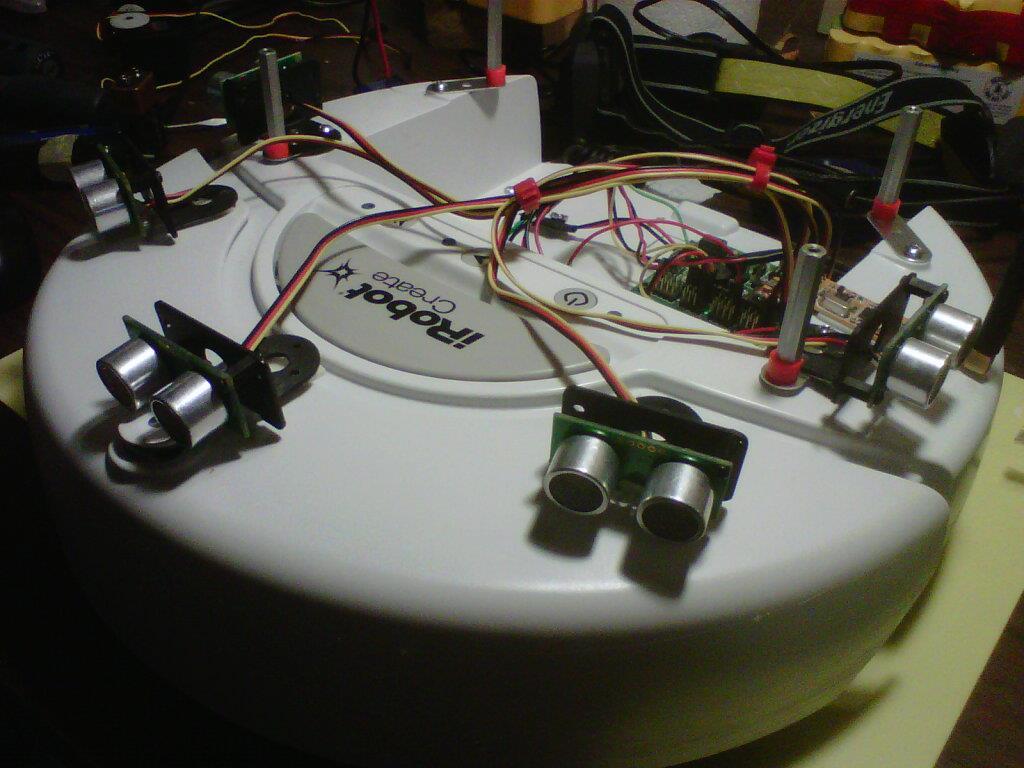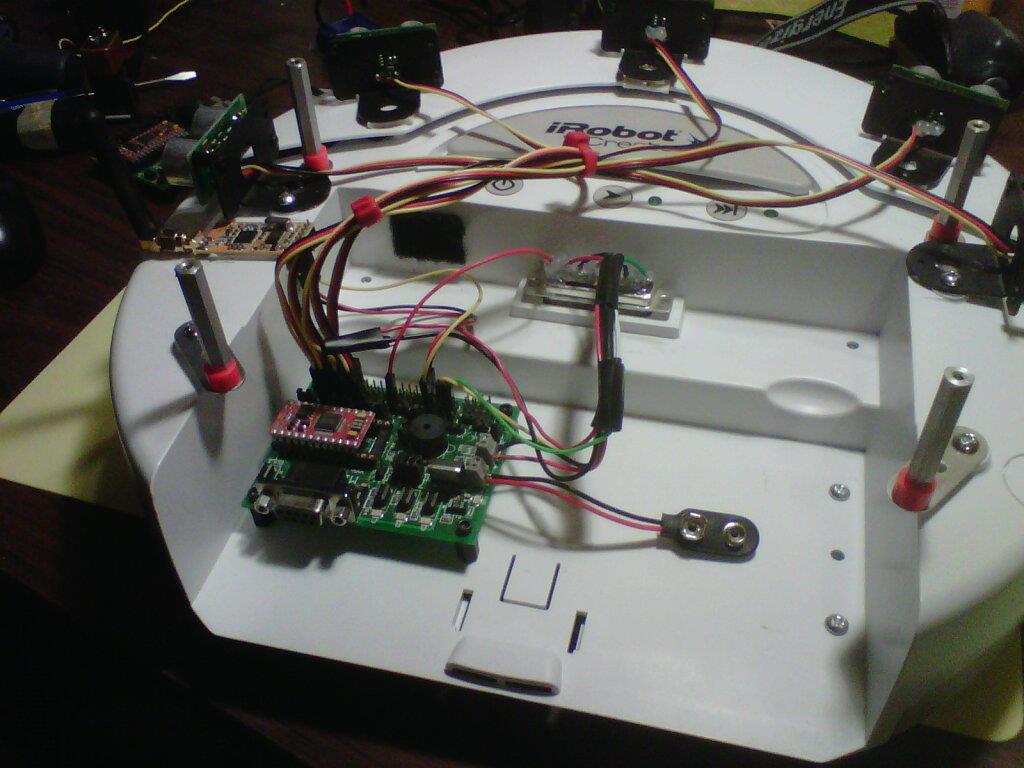Dunning-Kruger
Canada
Asked
— Edited
So here is a couple of pictures I just found of the last robot I made before I got my very first EZB3.... Spring of 2013 maybe? It was an iRobot Create that used a Basic Atom Pro (similar to a basic stamp but on steroids)
- Basic Atom Pro 24
- Lynxmotion botboard version 1
- 5 SFR05 pings
- CP210 wireless data transceiver
- hours of programming.... and what did it do.... wait for it.... LOL
It just roamed around trying not to bump into things.... However it did report stuff like low battery voltage as the send and receive serial was pretty good on the Atom Pro. Actually I was able to read all the Create's sensor data...



Hey, at least it wasn't a line follower If see one more line follower robot project pitched as Advanced AI robotics! my head will explode.
If see one more line follower robot project pitched as Advanced AI robotics! my head will explode.
Alan
Actually @Alan... I think you're the one who sold me my first ezb3 and the old camera lol... I promise no line following robots with the new ezb4 1/2
I promise no line following robots with the new ezb4 1/2
My last one before EZ-Robot was in about 1999. I cant even remember the name of it. It used a TI cmos for its brain. It had continuously rotating servos for wheels. There wasn't even a ping sensor on it. It had a series of buttons around a circular base that were connected by a floating acrylic ring that was used to detect when it ran into something. There were some photo sensors on be bottom and IR transmitters with separate IR receivers for distance measurement stuff. It had a head with a servo the had 3 photo sensors on it. It was a pain to program to do anything...
I took a long break after that and then decided to take a look to see what was out a couple of years ago. I found the wall-e video from DJ on you tube and that is all it took. I downloaded ARC and waited for the V4 to come out. I found the community and that is all she wrote. Finally my understanding of computers had some relevance in robotics.
@David... that's funny. I came up the microcontroller way... I used PCs only to program the controllers so PCs were not really involved much in my world of robotics for me... Microcontrollers don't need computers except to program them... You came in from the computer side it looks like.... So EZ Robot has made the "Robot Controller" the next step over a basic microcontroller... it adds PC to an IO capable controller (ezb4).... This is a perfect time for you to enter back into robotics...
And this was my whole reasoning behind embedding the ezb in a PC... The next evolution of robotics (to me anyway) should be the "Robot PC"... Raspberry Pi is trying to do it, but the software is hard to learn and the PI still sucks at IO... EZ Robot has the software (ARC) and part of the hardware (ezb).... now it seems logical to combine the software and additional hardware (pc and the ezb's IO) for and all in one "Robot PC"... Anyway, just musings...
It is getting closer. The latta panda is trying to do this. I love the idea personally. I like the thought of a single device for this type of thing, but understand the difficulties in keeping up with technology with it also. So many computer part upgrades in a very limited window...
It is an interesting time for sure for me in robotics. I agree that I came back at the perfect time for me.
@David... fair enough but even controllers go out of date... point... the ezb3 was quickly replaced by the ezb4 and now we are looking at the ezb4 1/2 and maybe even the EZB5... So just like PCs the controllers become outdated at about the same rate....
So if I bought a hypothetical ezbPC for say $199 (making this up) I would probably be happy with maybe a 2-3 year product up grade cycle?
The issue that I have with computers in general is that there are parts that I want to be able to upgrade as time goes on. This isn't really possible on laptops or tablets and the like. I don't like replacing the entire computer when there is a single component that is cause the slowness.
I like modular approaches to technology. I like things that plug in and are replaceable. Because of this, I think it would be cool to have a computer that accepts an EZ-B as an attached device (maybe plug it into a socket or something). This allows you to replace the v4 with the v5 and so on as long as the socket stays the same.
This is easier said than done. Examples are ISA, E-ISA, PCI and every other variation of bus that computers have gone through. This has been the issue with computers for a long time and I don't see an end to it really. Technology changes so quickly.
I normally opt for the best money can buy when buying technology because my hope is that it will last for a couple of years. With Atom processors I don't think that it is really possible for someone like me to be happy with its performance two years down the road. I have tried to adapt a philosophy of "it runs the app I need it to good enough" but it is against my nature due to work mainly. My job is to find the fastest technology in order to keep up with the demands of the growing company. It is very hard to stay ahead of this curve and once behind it, it gets very expensive to get back ahead of it.
This is all changing with service architectures where the PC isn't where a majority of the work is performed anymore. This is a good thing but costs money to use these. Now that network speeds are good enough both locally and globally, I think this is the direction that things will ultimately end up going. This allows the hardware to stay light on the clients end and allows software updates to improve speed instead of hardware updates. My hope is that this will allow a device to stay viable for 5+ years. The communication channel speed becomes the issue that needs to continuously be improved upon. That too is happening so I think this is a reality.
Where this comes into our world is that what you are saying is possible but expensive. I would love to see it happen. I would love to be able to take something like this and make it last for 5 or so years and be happy with it. The only way that I see that happening though is if there is an upgrade-able device somewhere else that is doing the work with the ever growing amount of data that people want/need to access.
@David... I actually just now see the glaring error of my thinking... I am a "power" user of ez robot and I know you are too... Many of us are... However, the kid down the street or the newbie to robotics or just the average user just wants to build his "JD" and easily and quickly program it... EZ Robot can sell thousands (and have) to these kids and newbies or they can sell a couple of hundred hypothetical EZBPCs to us power users... As much as I would want one of these the decision by ez robot to go the route and add additional connectivity (usb) was the right business decision because everyone (newbies, kids, and power users) will benefit. It just makes more sense that will sell more ezbs and accessories like the new comms board...